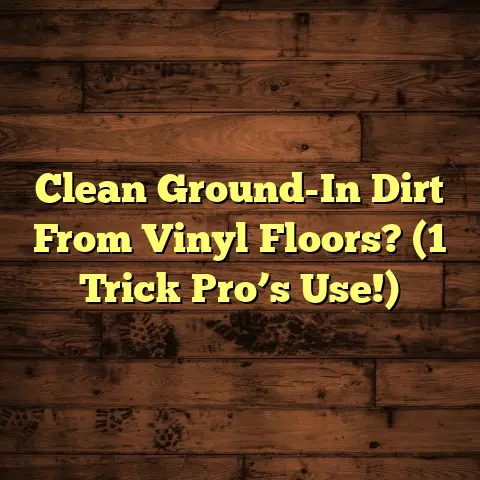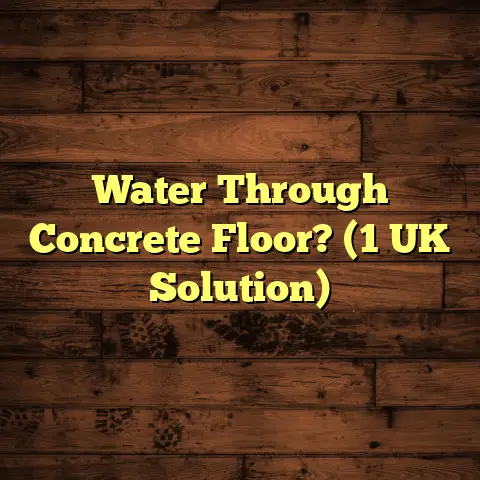Suspended Concrete Floors: Handling? (4 Subfloor Keys!)
Chances are, you were walking on a suspended concrete floor. They’re pretty cool, right?
As a flooring contractor with years of experience, I’ve seen these floors transform spaces.
They offer design flexibility, impressive durability, and they’re changing the game in construction.
But here’s the deal: these floors aren’t just poured and forgotten. There’s a real art to handling them.
And that’s what I’m here to share with you.
Think of this as your insider’s guide to understanding and mastering suspended concrete floors.
We’ll dive deep into what makes them tick and, more importantly, how to get them right from the start.
Ready? Let’s get started!
Section 1: Understanding Suspended Concrete Floors
So, what exactly is a suspended concrete floor?
Simply put, it’s a concrete floor that isn’t directly supported by the ground beneath it.
Instead, it’s elevated and supported by a framework of beams, columns, or walls.
Think of it like a bridge, but for your floor!
Why is this important?
Well, suspended floors can span longer distances than traditional slabs-on-grade, giving architects more freedom.
They also offer better insulation, soundproofing, and can even help with fire resistance.
| Feature | Suspended Concrete Floor | Traditional Floor |
|---|---|---|
| Support | Beams/Columns/Walls | Ground |
| Span | Longer | Shorter |
| Insulation | Better | Less |
| Soundproofing | Better | Less |
| Fire Resistance | Higher | Lower |
Material Matters:
We’re not just talking about any old concrete here.
The concrete mix itself is often specially designed for the application.
It might include admixtures to control shrinkage, increase strength, or improve workability.
Reinforcement is also key. Steel rebar or wire mesh is embedded within the concrete to provide tensile strength.
This helps the floor resist bending and cracking under load.
Examples in Action:
Think of iconic buildings with large, open spaces.
Many museums, libraries, and modern office buildings use suspended concrete floors to achieve their designs.
For example, the Sydney Opera House utilizes suspended concrete extensively.
This allows for its distinctive shape and vast interior spaces.
Section 2: The Importance of Handling Suspended Concrete Floors
Okay, so you know what suspended floors are.
But why is how you handle them such a big deal?
Imagine building a house of cards. If the foundation isn’t solid, the whole thing comes crashing down, right?
It’s the same with suspended concrete floors.
If you don’t handle them correctly during construction, you could end up with some serious problems down the line.
Potential Pitfalls:
- Cracking: Improper support or uneven load distribution can lead to cracks in the concrete.
- Settling: The floor might sink or settle over time if the underlying structure isn’t strong enough.
- Improper Load Distribution: If the weight isn’t distributed evenly, certain areas could be overloaded.
Subfloor Preparation: The Foundation for Success:
Think of the subfloor as the canvas for your masterpiece.
It’s the layer between the structural support and the finished flooring.
Proper subfloor preparation is absolutely crucial for the long-term performance of your suspended floor.
It ensures a level, stable, and moisture-resistant surface for the final flooring material.
Section 3: The 4 Subfloor Keys for Handling Suspended Concrete Floors
Alright, let’s get down to the nitty-gritty.
Here are the four subfloor keys that will make or break your suspended concrete floor project:
1. Key 1: Adequate Support and Load Distribution
This is where the rubber meets the road.
Your suspended floor needs a solid support system to handle the weight it’s designed to carry.
Support Systems:
- Beams: Horizontal structural members that support the floor slab.
- Girders: Larger beams that support other beams.
- Joists: Smaller, closely spaced beams that support the floor sheathing.
- Columns: Vertical supports that transfer the load to the foundation.
Load Calculation:
You can’t just guess at how much weight your floor needs to support.
You need to calculate the load requirements based on the building’s design and intended use.
This includes:
- Dead Load: The weight of the floor itself, including the concrete, reinforcement, and finishes.
- Live Load: The weight of people, furniture, equipment, and other movable objects.
Building codes typically specify minimum load requirements for different types of buildings.
For example, residential buildings have different load requirements than commercial buildings.
Ensuring Proper Distribution:
The goal is to distribute the load evenly across the support system.
This prevents localized stress and reduces the risk of cracking or settling.
Engineers use structural analysis software to model the floor system and identify potential weak points.
This allows them to optimize the design and ensure adequate support.
2. Key 2: Moisture Management
Moisture is the enemy of concrete.
It can lead to a whole host of problems, including:
- Mold Growth: Moisture creates a breeding ground for mold and mildew.
- Corrosion: Moisture can corrode the steel reinforcement within the concrete.
- Freeze-Thaw Damage: In cold climates, moisture can freeze and expand, causing the concrete to crack.
Preventing Moisture Intrusion:
- Vapor Barriers: These are impermeable membranes that prevent moisture from rising from the ground.
- Drainage Systems: These systems channel water away from the foundation and prevent it from accumulating around the floor.
- Waterproofing: Applying a waterproof coating to the concrete surface can help to prevent moisture penetration.
Testing for Moisture:
Before installing any flooring materials, it’s crucial to test the concrete for moisture content.
There are several methods for doing this, including:
- Calcium Chloride Test: This test measures the amount of moisture vapor emitted from the concrete.
- Relative Humidity (RH) Test: This test measures the relative humidity within the concrete slab.
If the moisture content is too high, you’ll need to take steps to dry the concrete before proceeding.
This might involve using dehumidifiers, fans, or other drying equipment.
3. Key 3: Thermal Considerations
Concrete is a good thermal conductor.
This means that it can transfer heat easily.
In the winter, heat can escape through the floor, making your building colder and increasing your energy bills.
In the summer, heat can enter the building through the floor, making it hotter and increasing your cooling costs.
Insulation Options:
- Rigid Foam Insulation: This type of insulation is typically installed beneath the concrete slab.
- Spray Foam Insulation: This type of insulation can be sprayed onto the underside of the slab.
- Insulated Concrete Forms (ICFs): These forms are used to build the walls of the building and provide insulation for the floor.
Thermal Bridging:
Thermal bridging occurs when a conductive material creates a pathway for heat to flow through the insulation.
For example, a steel beam that extends through the insulation can act as a thermal bridge.
To mitigate thermal bridging, you can use thermal breaks, which are materials that have low thermal conductivity.
4. Key 4: Surface Preparation and Finishing
Once the concrete is poured and cured, it’s time to prepare the surface for the final finish.
This involves:
- Cleaning: Removing any dirt, debris, or contaminants from the surface.
- Grinding: Leveling the surface and removing any imperfections.
- Patching: Filling any cracks or holes in the surface.
Finishing Techniques:
- Polishing: Grinding the concrete to a smooth, glossy finish.
- Staining: Applying a stain to the concrete to add color and depth.
- Sealing: Applying a sealant to the concrete to protect it from moisture and stains.
Step-by-Step Guide to a High-Quality Finish:
- Clean the surface thoroughly.
- Grind the surface to the desired level of smoothness.
- Patch any cracks or holes.
- Apply a stain (optional).
- Apply a sealant.
- Allow the sealant to dry completely.
- Polish the surface (optional).
Section 4: Best Practices for Handling Suspended Concrete Floors
Alright, let’s wrap things up with some best practices for handling suspended concrete floors.
- Training and Certification: Make sure that your workers are properly trained and certified in the installation and maintenance of suspended floors.
- Technology: Utilize advanced monitoring systems and construction management software to improve handling practices.
Section 5: Conclusion
So, there you have it: a comprehensive guide to handling suspended concrete floors.
Remember those four subfloor keys:
- Adequate Support and Load Distribution
- Moisture Management
- Thermal Considerations
- Surface Preparation and Finishing
By following these guidelines, you can ensure the longevity and performance of your suspended concrete floor system.
Don’t be afraid to embrace the advancements in suspended concrete floor technology.
They can help you enhance the quality and durability of your construction projects.
Good luck, and happy building!





